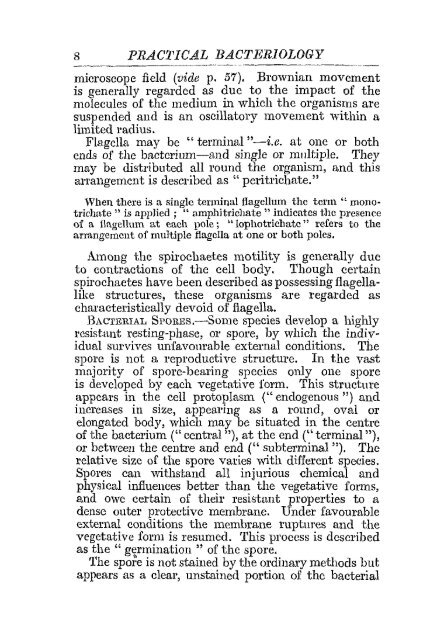AGf~ICULTURAL RESEARCH, PUSA.
AGf~ICULTURAL RESEARCH, PUSA.
AGf~ICULTURAL RESEARCH, PUSA.
Create successful ePaper yourself
Turn your PDF publications into a flip-book with our unique Google optimized e-Paper software.
8 PRAC'l'ICAL BACTERIOLOGY<br />
---------_<br />
microscope field (vide p. 57). Brownian movement<br />
is generally regarded as due to the impact of the<br />
molecules of the medium in which the organisms are<br />
suspended and is an oscillatory movement within a<br />
limited radius.<br />
Flagella may be "terminal "-i.c. at one or both<br />
ends of the bacterium-and single or mllltiple. They<br />
may be distributed all round the organism, and this<br />
arrangement is described as " peritrichate. "<br />
When there is a single terminal flagellum the term " monotrichate<br />
" is applied; .. amphitricl1ate " indicates thc presence<br />
of a flagellum at each pole; " lophotrichate" refers to the<br />
arrangement of multiple f1agclla at one or both poles.<br />
Among the spirochaet.es motility is generally due<br />
to contractions of the cell body. Though certain<br />
spirochaetes have been described as possessing flagellalike<br />
structures, these organisms are regarded as<br />
characteristically devoid of flagella.<br />
BACTERIAL SroREs.-Smne species develop a highly<br />
resistant resting-phase, 01' spore, by which the individual<br />
survives unfavourable external conditions. The<br />
spore is not a reproductive structure. In the vast<br />
majority of spore-bearing species only one spore<br />
is developed by each vegetative i'm'm. This structure<br />
appears in the cell protoplasm (" endogenous ") and<br />
increases in size, appearing as a round, ovaloI'<br />
elongated body, which may be situated in the centre<br />
of the bacterium (" central "), at the end (" terminal "),<br />
or between the centre and end (" subterminal "). The<br />
relative size of the spore varies with different species.<br />
Spores can withstand all injurious chemical and<br />
physical influences better than the vegetative forms,<br />
and owe certain of their resistant properties to a<br />
dense outer protective membrane. Under favourable<br />
external conditions the membrane ruptures and the<br />
vegetative form is resumed. This process is described<br />
as the " germination " of thc spore.<br />
'l'he spore is not stained by the ordinary methods but<br />
appears as a clear, unstained portion of the bacterial

















